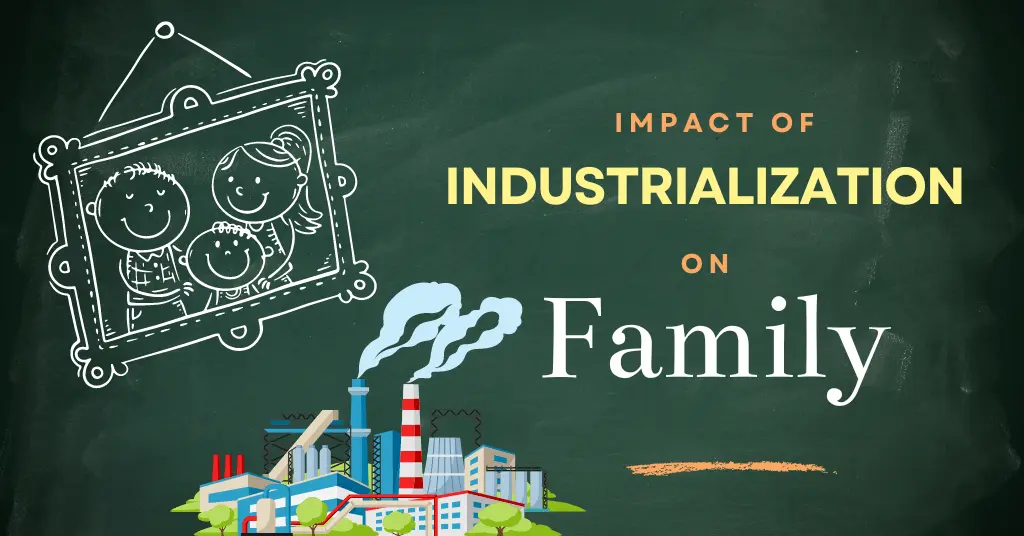AI Answer Evaluation Platform Live Now. Try Free Answer Evaluation Now
Impact of Industrialization on Family
Industrialization, the engine of economic and social change, has been a pivotal force in shaping societies around the world. The transformative wave of industrialization, initiated during the 18th century, has since reached every corner of the globe, influencing and altering virtually every aspect of life.

In addressing this topic, we are confronted with a multitude of complexities and variations across societies. The following discussion will, therefore, provide a comprehensive, detailed analysis of the ways industrialization has molded family structure, dynamics, and roles, with an aim to shed light on the ongoing and future implications of these changes.
Historical Perspective and Evolution
Pre-Industrial Family Structure
Before the advent of industrialization, families predominantly lived in rural areas and participated in agricultural work. The family was a unit of production; all members contributed to the family’s livelihood. This fostered interdependence and unity within the family.
Table 1: Characteristics of Pre-Industrial Family
| Characteristic | Description |
|---|---|
| Family Structure | Extended family |
| Work and Family Life | Integrated |
| Interdependence | High |
| Primary role | Unit of Production |
Impact of Industrialization
Industrialization brought about significant shifts in the economic, social, and cultural realms. The subsequent sections will delve into these aspects.
Economic Impact
The Shift from Extended to Nuclear Family
Industrialization led to a shift from rural to urban living, necessitating changes in family structure. The compact, nuclear family became more common, replacing the extended family as the primary social unit (Sassler, 2010). The reasons were multifaceted.
- Space Constraints: The physical limitations of urban dwellings made accommodating extended families impractical.
- Job Opportunities: The promise of better jobs in urban factories led many to migrate, often leaving their extended families behind.
- Change in Economic Dependence: Industrial jobs offered individual wages, making people financially independent, and diminishing the need for collective family labor.
Table 2: Comparison of Pre-Industrial and Industrial Family Structures
| Characteristic | Pre-Industrial Family | Industrial Family |
|---|---|---|
| Structure | Extended family | Nuclear family |
| Work-Life Integration | High | Low |
| Interdependence | High | Reduced |
| Primary Role | Unit of Production | Unit of Consumption |
Social Impact
Changing Gender Roles and Family Dynamics
With the advent of industrialization, the public-private dichotomy emerged, leading to distinct gender roles within the family. Men were associated with the ‘public’ realm of paid work, while women were confined to the ‘private’ realm of the household (Cott, 1977).
However, as industrialization progressed, women began participating in the workforce, leading to a shift in power dynamics within the family (Goldscheider, Bernhardt, & Lappegård, 2015). This not only gave women financial independence but also raised questions about traditional gender roles and norms.
Rise in Single-Parent Families
The dynamics of industrialization contributed to the rise of single-parent families. Factors such as increased divorce rates, the normalization of out-of-wedlock childbirth, and the empowerment of women to raise children independently all played a role in this shift (McLanahan, 2004).
Cultural Impact
Changes in Child-Rearing Practices
Industrialization affected child-rearing practices significantly. With the nuclear family becoming dominant, parents started investing more resources and attention in fewer children, promoting a child-centered family culture (Zelizer, 1985).
The advent of compulsory education, a product of industrialization, also altered the role of families in children’s socialization. Previously the family was the primary institution responsible for children’s social and vocational education; now schools assumed this role.
Consumerism and the Family
The consumer culture born out of industrialization impacted family dynamics. The family evolved from a production unit into a consumption unit (Mintz, 1985). This shift affected family roles, with parents, particularly mothers, taking on the responsibility of consumer decision-making for the family.
Conclusion
In tracing the trajectory of industrialization’s impact on the family, it is clear that its effects are complex and multifaceted. From altering family structures and economic functions to revolutionizing gender roles, child-rearing practices, and family dynamics, industrialization has deeply impacted the familial fabric of societies.
As we move further into the era of post-industrialization, these changes are continuing to evolve, posing new challenges and opportunities for families. Recognizing and understanding these impacts is critical in formulating policies and initiatives that support families and promote societal welfare.
References
- Cott, N. F. (1977). The Grounding of Modern Feminism. Yale University Press.
- Goldscheider, F., Bernhardt, E., & Lappegård, T. (2015). The Gender Revolution: A Framework for Understanding Changing Family and Demographic Behavior. Population and Development Review, 41(2), 207-239.
- McLanahan, S. (2004). Diverging destinies: How children are faring under the second demographic transition. Demography, 41(4), 607-627.
- Mintz, S. W. (1985). Sweetness and Power: The Place of Sugar in Modern History. Penguin Books.
- Sassler, S. (2010). Partnering Across the Life Course: Sex, Relationships, and Mate Selection. Journal of Marriage and Family, 72(3), 557-575.
- Zelizer, V. A. (1985). Pricing the Priceless Child: The Changing Social Value of Children. Princeton University Press.



